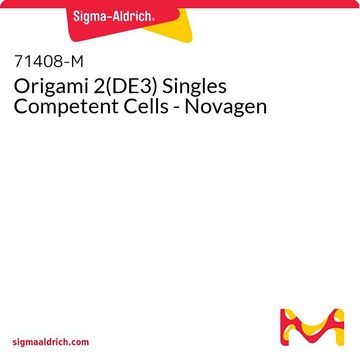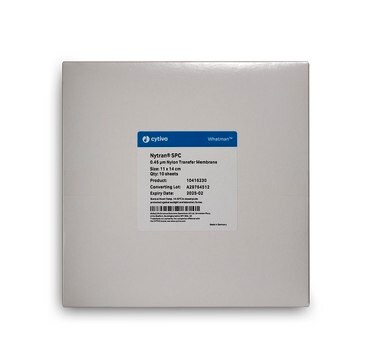71346-M
Origami 2(DE3)pLysS Competent Cells - Novagen
Escherichia coli, rod shaped
Sinónimos:
Novagen Competent Cells
About This Item
Productos recomendados
product name
Origami 2(DE3)pLysS Competent Cells - Novagen, Origami 2 strains have mutations in glutathione reducatase(gor) and thioredoxin reductase (trxB), facilitating proper disulfide bond formation. T7 lysozyme expression suppresses basal T7 expression.
origen biológico
Escherichia coli
Nivel de calidad
fabricante / nombre comercial
Novagen®
condiciones de almacenamiento
OK to freeze
modo de crecimiento
adherent or suspension
morfología
rod shaped
técnicas
microbiological culture: suitable
transformación celular
transformation efficiency: 2×106 cfu/μg
Condiciones de envío
dry ice
temp. de almacenamiento
−70°C
Categorías relacionadas
Descripción general
This product contains genetically modified organisms (GMO). Within the EU GMOs are regulated by Directives 2001/18/EC and 2009/41/EC of the European Parliament and of the Council and their national implementation in the member States respectively. This legislation obliges us to request certain information about you and the establishment where the GMOs are being handled. Click here for Enduser Declaration (EUD) Form.
DE3 indicates that the host is a lysogen of λDE3, and therefore carries a chromosomal copy of the T7 RNA polymerase gene under control of the lacUV5 promoter. Such strains are suitable for production of protein from target genes cloned in pET vectors by induction with IPTG.
pLysS strains express T7 lysozyme, which further suppresses basal expression of T7 RNA polymerase prior to induction, thus stabilizing pET recombinants encoding target proteins that affect cell growth and viability.
Componentes
•2 × 0.2 ml5 × 0.2 mlOrigami 2(DE3)pLysS Competent Cells
•2 × 2 ml4 × 2 mlSOC Medium
•2 ng2 ngTest Plasmid
Advertencia
Información legal
Código de clase de almacenamiento
10 - Combustible liquids
Certificados de análisis (COA)
Busque Certificados de análisis (COA) introduciendo el número de lote del producto. Los números de lote se encuentran en la etiqueta del producto después de las palabras «Lot» o «Batch»
¿Ya tiene este producto?
Encuentre la documentación para los productos que ha comprado recientemente en la Biblioteca de documentos.
Nuestro equipo de científicos tiene experiencia en todas las áreas de investigación: Ciencias de la vida, Ciencia de los materiales, Síntesis química, Cromatografía, Analítica y muchas otras.
Póngase en contacto con el Servicio técnico

